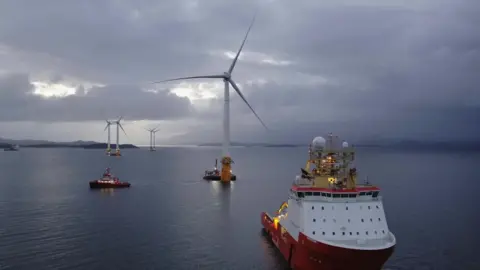Call to unlock Scotland's billion pound wind potential
 BBC
BBCThe development of floating wind farms, pioneered in Scotland, could deliver tens of billions to the economy, according to report from the industry.
The technology allows large turbines to be installed in much deeper waters than the sites traditionally chosen.
But it is expensive and funding needs to be ringfenced for its potential to be met, the report said.
The UK government said any investment in renewable electricity had to provide value for money.
The world's first floating wind farm, Hywind, opened two years ago about 15 miles off Peterhead in Aberdeenshire and it can now generate enough electricity to power 20,000 homes.
It consists of five giant turbines which are tethered to the sea bed but float upright on a sealed vase-like tube 78m deep.
Its bottom is filled with iron ore to weight the base and keep it upright in the water like a giant fishing float.
The renewables industry hopes the cutting edge technology will "unlock" new areas of the sea in deeper waters.
Until now, offshore wind farms have required steel frames - or jackets - to be positioned on the seabed to hold the turbines.
That meant most were located in the southern North Sea where the water is more shallow than along the Scottish coast.

The Hywind floating wind farm

- The tower, including the blades, stretches to 175m (575ft), dwarfing Big Ben
- Each tower weighs 11,500 tonnes
- The box behind the blades - the nacelle - could hold two double-decker buses
- Each blade is 75m - almost the wing span of an Airbus
- The turbines can operate in water up to a kilometre deep
- The blades on the towers have been a particular focus for innovation.
- Manufacturer Statoil says the blades harness breakthrough software - which holds the tower upright by twisting the blades to dampen motions from wind, waves and currents.

'Innovative technologies'
Morag Watson, director of policy at Scottish Renewables, said: "Scotland's offshore energy experience and our deep water wind resource means we're already a world leader in floating wind.
"This technology will be necessary to meet our net-zero emissions target and offers the most cost-effective pathway to delivering more than 50GW of offshore wind in UK waters."
The joint report, by RenewableUK and Scottish Renewables, estimates that floating wind can generate £33.6bn of economic activity by 2050, supporting 17,000 jobs.
But it calls for changes to government contracts for selling electricity which would see a separate pot of money to help make "innovative technologies" such as floating wind cost-competitive more quickly.
The Contracts for Difference (CfD) framework requires companies to bid competitively for deals to supply electricity.
But new technologies require significant capital investment which can be outbid by established projects like fixed offshore wind.
A spokesman for the Department for Business, Energy and Industrial Strategy added: "As we have always said, any form of low-carbon innovation or tech must represent best value for money for our hard working taxpayers.
"Not only have we recently launched our pivotal offshore wind sector deal, but we have also committed to holding another round of clean electricity auction in 2021.
"This will all help in our mission to go further and faster to end our contribution to climate change by 2050."
